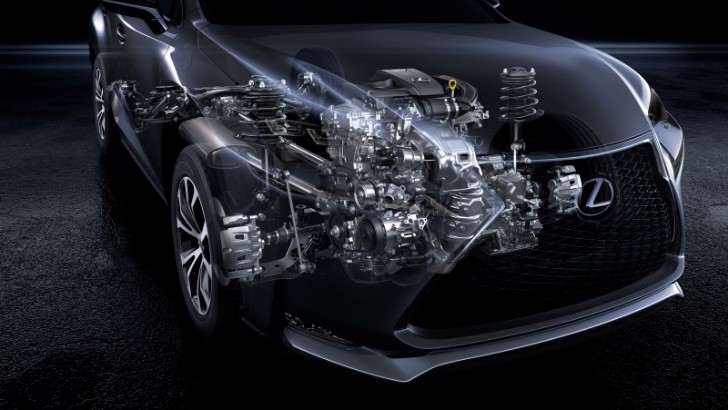Lexus launched their first turbocharged petrol engine bound to equip the European NX 200t. Since this is a premiere for Toyota’s luxury arm, we thought that a complete guide to this new 2.0-liter turbo engine would be a good and useful read.
Before we start going into deeper detail, you need to know that the 2.0-liter engine is the first in the world to combine a water cooled cylinder head with an integral, four-into-two exhaust manifold and a twin scroll turbocharger.
We’ll discuss this aspect later on as for now, we must also mention that the engine is meeting EURO 6 emissions requirements while returning an average fuel consumption of 7.7 l/100 km (31 mpg) and CO2 emissions of 178 g/km.
How it works
According to Lexus, the engine’s unique combination of technologies (water cooled cylinder head / four-into-two exhaust manifold / twin scroll turbocharger) was the solution to better responsiveness and minimal turbo lag plus enhanced low speed torque. But we’ll judge that after we actually test drive the car.
This way, VVT-iW allows the Atkinson cycle to be maintained by having a mid-position lock, which means that in cold weather, starting the car won’t become a matter of performance loss.
Lexus also mounted an air-to-liquid intercooler directly to the engine, a solution that reduces the intake volume downstream of the turbocharger, which, in theory, minimizes turbo lag.
The unit tips the scales at 160 kg (353 lb) and it underwent two test stages: over 10,000 hours of bench-testing and one million kilometers of extensive on-road testing.
Key figures
Lexus’s new 2.0-liter turbo petrol engine is good for 238 HP delivered between 4,800 and 5,600 rpm. Maximum torque is rated at 350 Nm (258 lb-ft) in the 1,650-4,000 rpm interval. On paper, this engine allows the NX 200t to accelerate from 0 to 100 km/h (62 mph) in 7.1 seconds, while top speed is set at 200 km/h (124 mph).
The unit is only available with a new six-speed automatic gearbox, a solution which Lexus might consider extending throughout their range.
We’ll discuss this aspect later on as for now, we must also mention that the engine is meeting EURO 6 emissions requirements while returning an average fuel consumption of 7.7 l/100 km (31 mpg) and CO2 emissions of 178 g/km.
How it works
According to Lexus, the engine’s unique combination of technologies (water cooled cylinder head / four-into-two exhaust manifold / twin scroll turbocharger) was the solution to better responsiveness and minimal turbo lag plus enhanced low speed torque. But we’ll judge that after we actually test drive the car.
1. Dual VVT-iW
The engine can run in both the Otto and Atkinson cycles thanks to the dual VVT-iW technology. In other words, the engine starts in the Otto cycle but runs in the fuel-efficient Atkinson cycle. This is where the dual variable valve timing technology comes into play: it adopts VVT-i to the exhaust valves and VVT-iW to the intake valves.This way, VVT-iW allows the Atkinson cycle to be maintained by having a mid-position lock, which means that in cold weather, starting the car won’t become a matter of performance loss.
2. Four-into-two manifold, twin scroll & air to liquid intercooler
Cylinders are paired by the four-into-two exhaust manifold system in close relation to their expansion or compression stroke. This is where the twin-scroll turbocharger comes into play, preventing exhaust gasses from each cylinder to interfere with each other. In practice, this should translate into high torque stretched along a wider rpm range.Lexus also mounted an air-to-liquid intercooler directly to the engine, a solution that reduces the intake volume downstream of the turbocharger, which, in theory, minimizes turbo lag.
3. Weight-saving features
Lexus wanted to build a light and compact engine for the European-bound NX 200t and in order to pull that off, the Japanese engineers came up with a bunch of solutions. The cylinder head cover, intake manifold and intake pipes are covered in a special resin and Lexus tells us that the engine was cast with low nickel content heat-resistant steel.The unit tips the scales at 160 kg (353 lb) and it underwent two test stages: over 10,000 hours of bench-testing and one million kilometers of extensive on-road testing.
Key figures
Lexus’s new 2.0-liter turbo petrol engine is good for 238 HP delivered between 4,800 and 5,600 rpm. Maximum torque is rated at 350 Nm (258 lb-ft) in the 1,650-4,000 rpm interval. On paper, this engine allows the NX 200t to accelerate from 0 to 100 km/h (62 mph) in 7.1 seconds, while top speed is set at 200 km/h (124 mph).
The unit is only available with a new six-speed automatic gearbox, a solution which Lexus might consider extending throughout their range.









